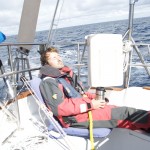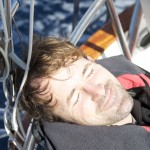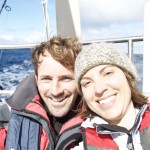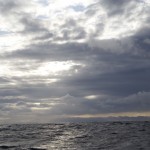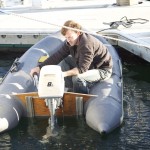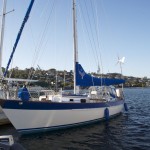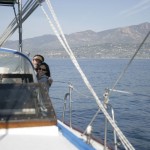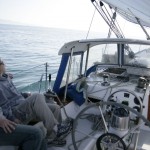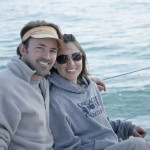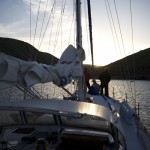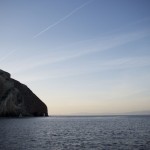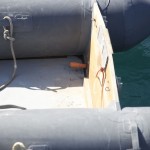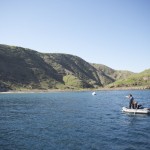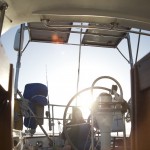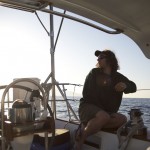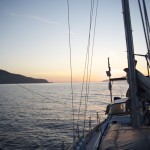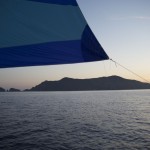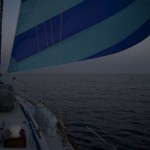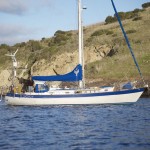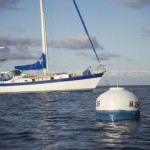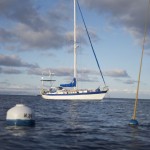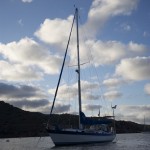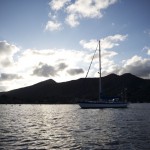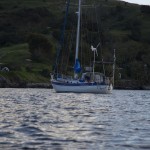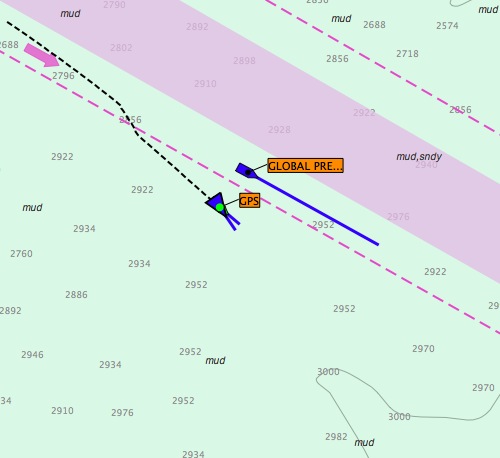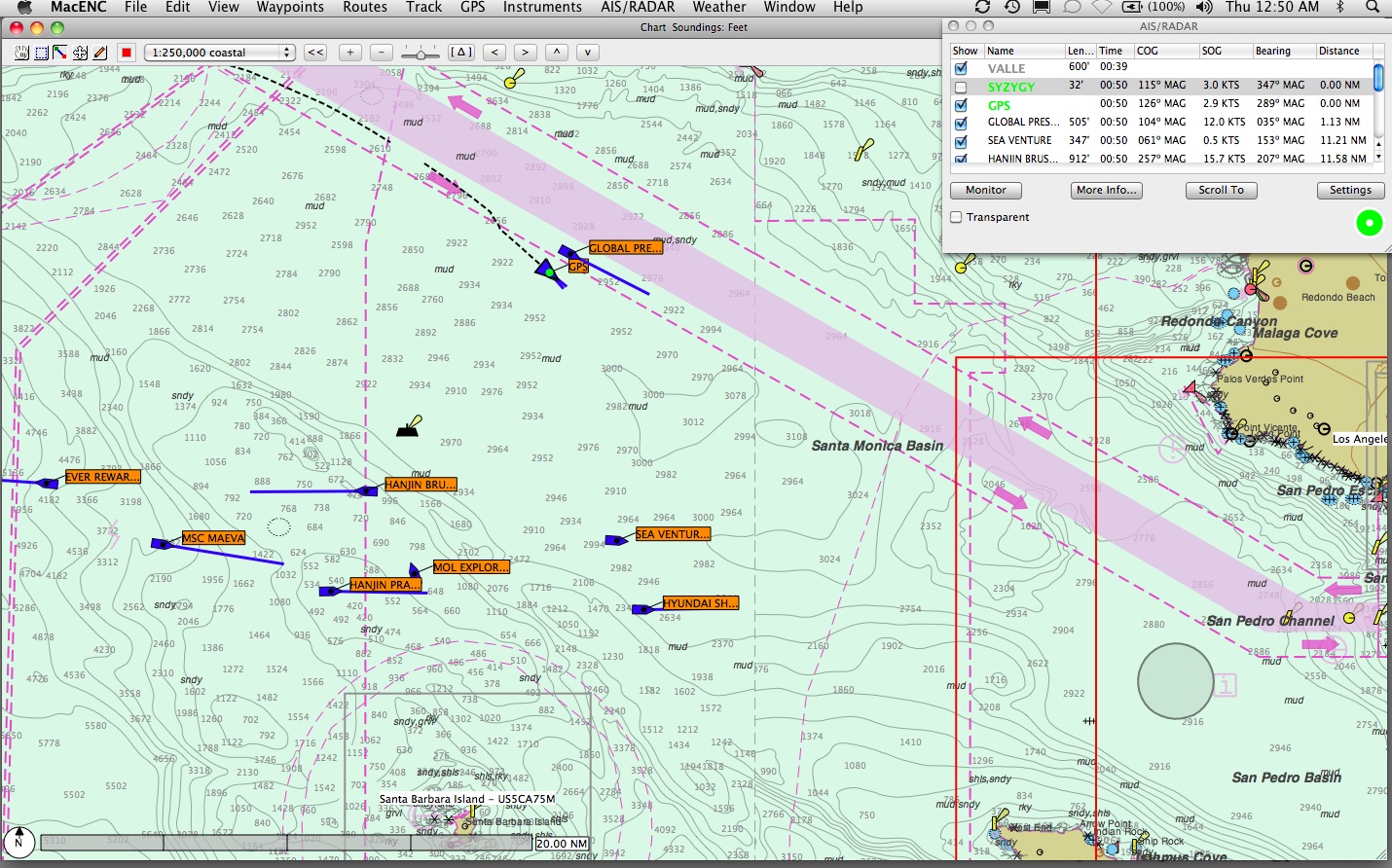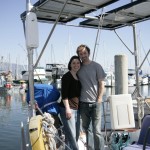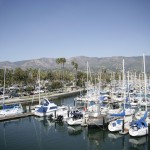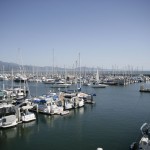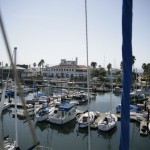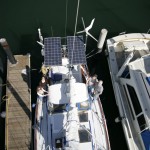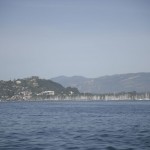Pete and Ray hopped a ferry on Catalina to catch a plane out of L.A. this past Saturday. Karen and I are extremely grateful to them for joining us during the first leg of our journey. Their mere presence on board to assist with watches would have been more than enough, but their assistance extended far beyond that. Pete fixed (finally, for real) our engine overheating problem, fixed the ssb, spliced the radar wiring together, repaired the windlass after I broke it, and got our outboard running, and that’s just what I can remember off the top of my head. Pete is better at working on boats than anyone I have either met or even heard of. I consider myself pretty capable at this point, but I felt like a novice apprentice in the presence of Pete. Together, Pete and Ray gave us great advice at every turn, and while we are understandably very excited to be off on our own, we will sorely miss Pete and Ray. Thanks Pete and Ray!
Karen and I departed Catalina on Sunday morning, bound for San Diego. It was a joyous departure, being alone for the first time. We experienced a consistent 20 knot winds out of the West and Northwest for the whole passage; this wind speed and direction allowed us to haul-ass the entire time. It was a fast, enjoyable, comfortable ride. It was wonderful to be out there alone, wonderful to be feeling good and sailing well.
There were two notable incidents: just before sunset we were hailed by an aircraft carrier, which identified itself as being at 20,000 yards, and would we please not come closer than 5,000 yards as they were doing “night exercises”. I thought to myself–isn’t a “yard” an inappropriate unit of distance in this case? Later in the evening I spotted a vessel off our port bow, and after a few minutes I determined that we were converging, and not wanting to collide with them I hailed them on the radio. During my radio call, I identified their exact position, and it took two attempts before they identified themselves as “warship 88” and thanked me as they had “only just noticed us” . . . and I thought to myself–what kind of warship doesn’t notice a sailing yacht first? I told them not to bother altering course, as I would pass behind them. We passed about 500 yards astern of them–close enough to see that yes, indeed, they certainly looked like a warship–and then they turned off all their lights. WTF? Pretty freaking unsafe to sit around with no lights on. What kind of boat sits around out in the ocean with all its lights off, especially when it can fail to notice an approaching vessel less than 4 miles away? Karen and I have no valid explanations. If it was hanging out there all stealth-like to look for smugglers or illegal immigrants, then maybe they should take lessons on reading their radar effectively–we had lights on, AIS on, and were headed right for them, after all, so what kind of small unlighted illegal boats are they ever going to find? Anyway, strange things happen out in the ocean I guess, like encountering incompetent stealth warships.
As it turned out, we made such good time that we ended up arriving at the entrance to San Diego around midnight. It being greatly preferred to enter during the daylight (a lesson learned during anchoring outside Santa Barbara in the dark), we decided to sail around killing time until the morning.
We proceeded to spend the next three hours messing around with sail combinations and positions, unsuccessfully attempting to stop the boat from sailing.
If one simply douses all the sails, attempting the sailing equivalent of “hanging out”, what happens is that the boat bobs around in the waves in a surprisingly violent way, while everything in the boat is rudely thrown from left to right and back in endless repetition until it all breaks, and furthermore sometime during that endless repetition all semblance of sanity departs from the minds of all crew on the boat. So we don’t do that.
Heaving to is the preferred method of “stopping” the boat. It is a balanced state in which the force of the jib and the main sail balance each other, working against each other, holding the boat slightly into the wind, such that the boat moves neither forward nor backward, but drifts directly downwind at about 1 knot. The basic position of the sails required to heave to is straight forward: jib sheeted to windward, main eased to leeward, rudder to leeward. Every boat is slightly different, however, and modern boats in particular can be hard to successfully heave to (so I have been told). I was under the impression that our boat, it being heavier, with a medium-length keel and skeg-hung rudder, would have no trouble heaving-to. I have discovered otherwise. None of the various methods Karen and I tried throughout the night were successful. With greater skill no doubt I will get it right, but no matter what I did that night our boat would sail forward. The slowest I got her to was 1.5 knots–if that was 1.5 knots drifting directly downwind I would have been satisfied, but alas it was 1.5 knots forward, and I would be satisfied with nothing less than a perfect textbook heave-to. Perhaps that was ambitious for 3 in the morning; perhaps I was being a little insane offshore in the pitch black in a healthy 20 knots of wind, but we were trying to kill time anyway and what else better did I have to do? Our boat would not be stopped. Don’t get me wrong, I am glad that our boat loves to sail, but clearly it will require further practice to get her to stop.
After four hours of putting sails up and down in the dark, within sight of all the lights of San Diego, Karen and I convinced ourselves that it would be just fine to enter the bay in the dark after all. We motored up the channel without incident, and were directed by the harbor police to tie up to a quarantine buoy for the rest of the night. This accomplished, we passed out for three hours, roused ourselves to motor over to the “cop dock” as they call it around here, and procured a transient slip for a few days at $10.50 a night in which to park the boat.
In retrospect, I am not happy with our late-night change of plans decision to enter the harbor. If we thought it was a poor choice at the start of the evening, it was certainly a worse decision after we were considerably more tired out. It all turned out to be perfectly fine and there were no close calls or dangerous aspects of entering the harbor, but it was still the wrong choice. With or without achieving a perfect heave-to, we could simply have sailed back and forth for a few more hours. Tiredness can be an unbelievably powerful force–somehow it convinced me at 4 in the morning that it would be light by the time we got into the harbor proper, which was a silly thing to believe considering it only took us 40 minutes from that point to reach the quarantine buoy. I suspect there will be many tired situations in the future, and so we would do well to remember it and to steel ourselves against it.
All in all, though, it was a safe and enjoyable first passage for Karen and I, and it greatly eased our minds about our ability to sail alone in a comfortable and happy fashion.
And, to the present: I am glad to be stationary in San Diego for a few days. We have a number of errands on our list: we need to tie up loose ends from our former life (bills, taxes, etc), purchase spares, and do a few maintenance tasks on the boat. It will be our last convenient chance to take care of things before heading into mexico–which we hope to do in about a week.
